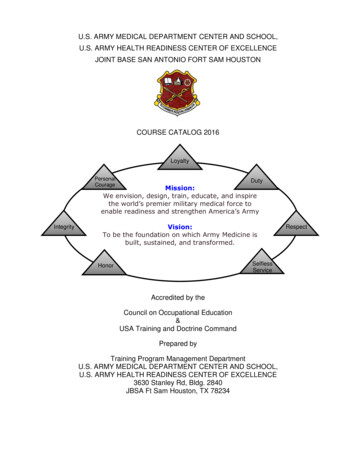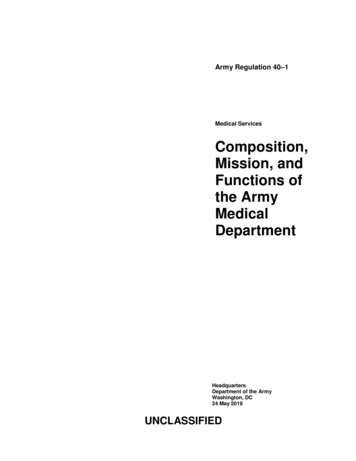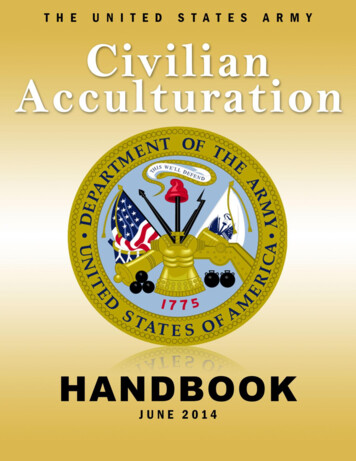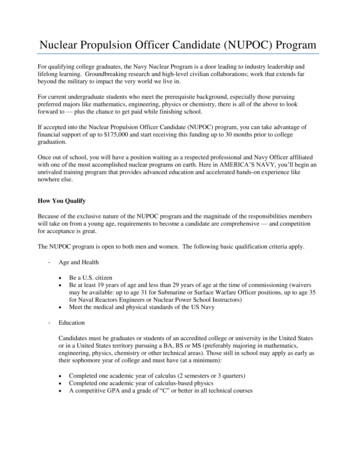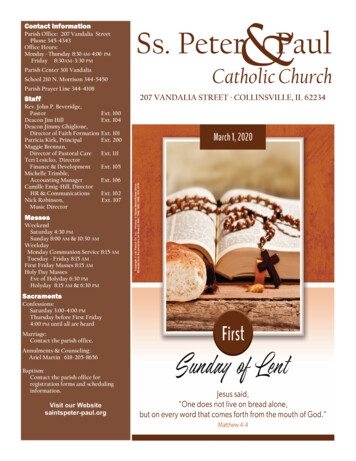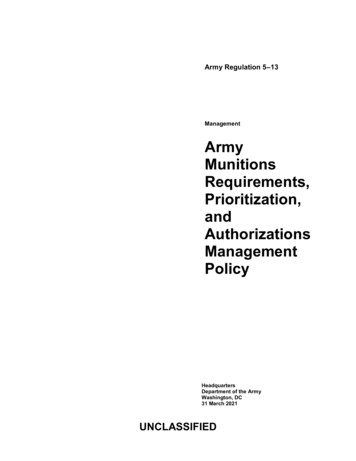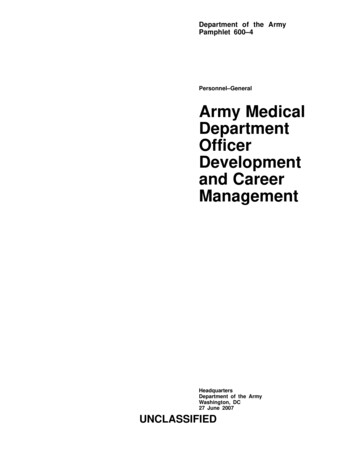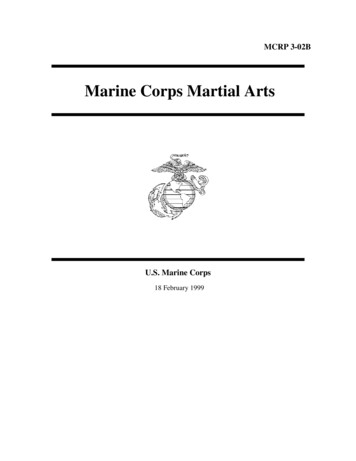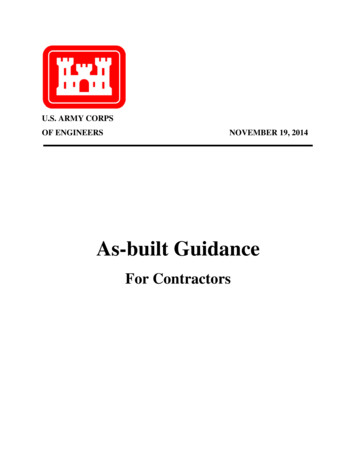
Transcription
U.S. ARMY CORPSOF ENGINEERSNOVEMBER 19, 2014As-built GuidanceFor Contractors
As-built Guidance for ContractorsEffective 11/19/2014TABLE OF CONTENTSPURPOSE . 5REFERENCES . 5DEFINITIONS . 5CAD STANDARDS .5GOVERNMENT FURNISHED CAD FILES (AS-DESIGNED CAD FILES) .5WORKING HARDCOPY DRAWINGS .6WORKING CAD DRAWINGS .6SHOP DRAWINGS .6FINAL HARDCOPY DRAWINGS .6FINAL CAD DRAWINGS .6AS-BUILT DRAWINGS .6GENERAL PROCEDURE FOR DEVELOPMENT/DELIVERY OF AS-BUILT DRAWINGS . 71.2.3.4.5.6.7.PROVIDE GOVERNMENT FURNISHED MATERIALS .7REVISION OF WORKING DRAWINGS .7QUALITY ASSURANCE OF WORKING DRAWINGS.7SUBMITTAL OF AS-BUILT DRAWINGS .7REVIEW OF AS-BUILT DRAWINGS .7RESOLVE ISSUES WITH AS-BUILT DRAWINGS .7ACCEPTANCE OF AS-BUILT DRAWINGS .7GOVERNMENT FURNISHED MATERIALS . 7REVISION OF WORKING DRAWINGS . 8GENERAL WORKING DRAWINGS REVISION GUIDELINES (HARDCOPY AND CAD) .8SHOP DRAWINGS .8REVISION OF WORKING HARDCOPY DRAWINGS . 9GENERAL WORKING HARDCOPY DRAWING REVISION GUIDELINES .9WORKING HARDCOPY DRAWING ADDITIONS .11WORKING HARDCOPY DRAWING DELETIONS .12RELOCATED FEATURES ON WORKING HARDCOPY DRAWINGS.12REVISION OF WORKING CAD DRAWINGS . 13CAD STANDARDS .13Drawing File Organization .13Design Area . 13Model Files and Sheet Files . 13Drawing Sheet Assembly . 14Electronic Drawing File Naming Conventions . 14Graphic Concepts .14Level Layer Assignments .15Page 2 of 21
As-built Guidance for ContractorsEffective 11/19/2014Standard Symbology .15GENERAL WORKING CAD DRAWING REVISION GUIDELINES .16PREPARATION OF FINAL CAD DRAWINGS .17QUALITY ASSURANCE AND REVIEW . 19QUALITY ASSURANCE OF WORKING DRAWINGS .19Review of Working Hardcopy Drawings.20Review of Working CAD Drawings .20SUBMITTAL AND ACCEPTANCE OF AS-BUILT DRAWINGS . 21SUBMITTAL OF AS-BUILT DRAWINGS .21REVIEW OF AS-BUILT DRAWINGS.21RESOLVE ISSUES WITH AS-BUILT DRAWINGS .21ACCEPTANCE OF AS-BUILT DRAWINGS .21Page 3 of 21
As-built Guidance for ContractorsEffective 11/19/2014TABLE OF FIGURESFIGURE 1 - USE OF DELTA TRIANGLES .10FIGURE 2 - WORKING HARDCOPY REVISION BLOCK .11FIGURE 3 - WORKING HARDCOPY DRAWING ADDITION .11FIGURE 4 - WORKING HARDCOPY DELETION .12FIGURE 6 - STANDARD CAD MODEL FILE NAMING CONVENTION .14FIGURE 7 - STANDARD CAD SHEET FILE NAMING CONVENTION .14FIGURE 8 - SAMPLE BORDER SHEET.15FIGURE 9 - COVER SHEET "RECORD DRAWING / AS-BUILT CONDITIONS" STAMP .18FIGURE 10 - TYPICAL DRAWING "AS-BUILT" STAMP.19Page 4 of 21
As-built Guidance for ContractorsEffective 11/19/2014PURPOSEThe purpose of this document is to provide guidance on the preparation of high quality as-built drawingsthat exhibit as-built conditions of the project. As-built drawings are an official record of the project atthe time construction is completed. The original “as-designed” contract drawings and specifications arerevised to show all additions, deletions and other changes made during construction of the project.Accurate as-built drawings are very important for project operation and maintenance and futuremodifications particularly for project features which are hidden from view.This document is not intended to supersede or replace any as-built requirements set forth in thecontract specifications, but is intended to provide guidance on meeting these requirements. Forcomplete contract requirements, see the General Requirements Section (01.78.00) of the contractspecification.REFERENCESThe following references will be required in the development of as-built drawings. Specific versions ofthe referenced documents to be used will be provided in the Contract Specifications.United States National CAD StandardThe CAD/BIM Technology Center A/E/C CAD StandardLocal CAD Standard(s) required by the Contract SpecificationDEFINITIONSCAD StandardsFor the purpose of this document, CAD Standards refer to those standards listed in the contractspecifications requirements section. These are the standards to be used when updating/creatingelectronic CAD drawing files. Please see the contract specification for details on the currently requiredCAD Standards.Government Furnished CAD Files (As-Designed CAD Files)The government furnished CAD files are the as-designed electronic CAD drawings in the format of thesoftware specified in the contract specification. This set of CAD drawings will reflect all bid amendments.Government Furnished CAD Files will also include CAD drawings developed during construction for thepurpose of modifying the original as-designed drawings. All Government Furnished CAD Files shall beprovided to the contractor as stated in the contract specification.Page 5 of 21
As-built Guidance for ContractorsEffective 11/19/2014Working Hardcopy DrawingsWorking Hardcopy drawings are the printed, hardcopy sets of drawings that are revised by markupduring the execution of the project to show the current as-built conditions. Please see the contractspecification for the requirements related to Working Hardcopy Drawings.Working CAD DrawingsWorking CAD Drawings are the electronic CAD Files that are revised in tandem with the WorkingHardcopy Drawings during execution of the project to show current as-built conditions. Please see thecontract specifications for the requirements related to Working CAD Drawings. (New ContractSpecification Paragraph required)Shop DrawingsA shop drawing is a drawing or set of drawings produced by the contractor, supplier, manufacturer,subcontractor, or fabricator. Shop drawings are typically required for pre fabricated components suchas elevators, structural steel, trusses, pre-cast, air handling units, millwork, etc. The shop drawing is themanufacturer’s or the contractor’s drawn version of information shown in the Contract Documents. Theshop drawing normally shows more detail than the Contract Documents. It is drawn to explain thefabrication and/or installation of the items.Final Hardcopy DrawingsThe Final Hardcopy Drawings are the completed Working Hardcopy Drawings including all markuprevisions which reflect final as-built conditions.Final CAD DrawingsThe Final CAD Drawings are the completed Working CAD Drawings that incorporate all changes shownon the Final Hardcopy Drawings and reflect the final as-built conditions of the project. ContractSpecification requires printed sets and PDF of the Final CAD Drawings to be submitted prior to Projectcloseout. The C-ANNO-REVS layer should not be displayed on the PDF and printed sets. Please refer tocontract specifications for all requirements.As-built DrawingsThe As-built Drawings will consist of the completed Final CAD Drawings and the completed FinalHardcopy Drawings which include modification during construction, field requested changes, shopdrawings and contractor designs required during construction. If the Working CAD Drawings andWorking Hardcopy Drawings are properly maintained during construction, when project construction iscomplete, the As-built Drawings should be near completion.Page 6 of 21
As-built Guidance for ContractorsEffective 11/19/2014GENERAL PROCEDURE FOR DEVELOPMENT/DELIVERY OF AS-BUILT DRAWINGS1. Provide Government Furnished Materials - At the Preconstruction Meeting, GovernmentFurnished Materials will be provided to the Contractor.2. Revision of Working Drawings - During Construction, the contractor will use theGovernment Furnished Materials to make revisions (changes, additions or deletions)reflecting as-built conditions. Revisions will include markups of Working Hardcopy Drawingsas well as edits to the Working CAD Drawings.a. The Contractor will mark-up Working Hardcopy Drawings as required by the ContractSpecification.b. Based on mark-up of the Working Hardcopy Drawings, the Contractor will update theelectronic Working CAD Drawings to meet contract requirements.3. Quality Assurance of Working Drawings - The Resident Engineer or designee will review theWorking Hardcopy Drawings and the electronic Working CAD Drawings as described in theContract Specification.4. Submittal of As-built Drawings - Upon completion of the Project, the Contractor will submitthe As-built Drawings (Final Hardcopy Drawings and Final CAD Drawings) that show the asbuilt conditions of the project.5. Review of As-built Drawings - The Resident Engineer and/or District Office personnel willperform a review of the As-built Drawings (Final Hardcopy Drawings and Final CADDrawings). From the review, the Resident Engineer will consolidate Government commentsidentifying issues that need to be resolved prior to Government acceptance.6. Resolve Issues with As-built Drawings – Contractor will address, resolve and document allissues identified by the Government during review.7. Acceptance of As-built Drawings – When the Government determines that the Contractorhas met the requirements of the Contract Specifications; the As-built Drawings will beaccepted. It should be noted that it may be necessary to perform several iterations of thereview, comment and resolution process prior to acceptance. Upon acceptance, theGovernment will release any retained payments.GOVERNMENT FURNISHED MATERIALSAt the Preconstruction Meeting, Government Furnished Materials will be provided to the Contractor.This will include at a minimum an optical Disc (CD or DVD) which contains the Government FurnishedCAD Files. In addition, the Government will provide two (2) hardcopy prints of the electronic CAD fileswhich reflect the as designed drawings and all bid amendments.For modifications during construction that require additional or significantly altered drawings, theGovernment will provide the new or modified drawing to the Contractor along with instructions forupdating the Working Hardcopy Drawings and Working CAD Drawings.Page 7 of 21
As-built Guidance for ContractorsEffective 11/19/2014REVISION OF WORKING DRAWINGSGeneral Working Drawings Revision Guidelines (Hardcopy and CAD)During Construction, the contractor will use the Government Furnished Materials to make revisions(changes, additions or deletions) reflecting as-built conditions. Revisions will include markups of theWorking Hardcopy Drawings as well as edits to the Working CAD Drawings. Revisions to the workingdrawings will include, but not be limited to, the following list. Correct grade, elevations, cross section, or alignment of roads, earthwork, structures or utilitiesif revised from the Contract Plans.The topography, invert elevations and grades of drainage installed or affected as part of theproject construction.The actual location of existing and new sub-surface utility lines including valves, splice boxes,etc.The location of unusual or uncharted obstructions that are encountered in the contract workarea during construction.Location, extent, thickness, and size of stone protection particularly where it will be normallysubmerged by water.Changes in the design, dimensions, specifications or location of project features and equipment.Actual location of anchors, construction and control joints, etc., in concrete.Changes in details of design or additional information obtained from working drawings specifiedto be prepared and/or furnished by the Contractor, including but not limited to, fabrication,erection, installation plans and placing details, pipe sizes, insulation material, dimensions ofequipment foundations, etc.Systems designed or enhanced by the Contractor, such as HVAC controls, fire alarm, firesprinkler, irrigation systems, etc.If borrow material for this project is from sources on Government property, or if Governmentproperty is used as a spoil area, the Contractor shall furnish a contour map of the final borrowpit/spoil area elevations.Layout and schematic drawings of electrical circuits and piping.Correct dimensions and details transferred from shop drawings.Changes or modifications that result from the final inspection.Shop DrawingsAll shop drawings will be incorporated into the as-built drawings. Incorporation of a shop drawing mayrequire revising Working Drawings to reflect the correct dimensions and details of a project feature.Typically, Shop Drawings will be provided in electronic CAD file format and conform to the CADStandards required in the Contract Specification. Hand drawn or printed paper shop drawings will not beaccepted in place of electronic CAD drawings. Contract Specification may, however, require submittal ofPage 8 of 21
As-built Guidance for ContractorsEffective 11/19/2014printed hardcopy shop drawings in addition to electronic CAD drawings. If Contract Specification allowfor the acceptance of shop drawing which are smaller than the CAD Standard sheet size (i.e. 8.5"x11" or11"x17" etc.) the sheets will be referenced into the standard size border sheet used in the GovernmentFurnished CAD Drawings. The Contract Specification may also allow PDF Shop Drawings not prepared bythe contractor to be referenced into the standard size border sheet. Please refer to ContractSpecification for complete requirements and Shop Drawing acceptance.Typically, shop drawings will be drawn at the same scale as similar drawings in the GovernmentFurnished CAD Drawing set (e.g., fire alarm systems shall be drawn to the same scale as the plumbing orelectrical drawings). Sheet Identification Number, Detail and View Identification Numbers, etc. will linkdetails and views to existing drawings. The Index of Drawings will also need to be revised to show theadditional sheet(s) with the appropriate Sheet Title and Identification Number.REVISION OF WORKING HARDCOPY DRAWINGSGeneral Working Hardcopy Drawing Revision GuidelinesThe number of Working Hardcopy Drawing sets that must be maintained and the frequency at whichthey must be revised is provided in the Contract Specifications. Typically, revision of the WorkingHardcopy Drawing set will be performed on a weekly basis. At a minimum, at least one WorkingHardcopy Drawing set will be on-site at all times.Markups will be completed on black line (Grayscale) prints of the most current drawing. If a ContractModification requires revised drawings during construction, an up-to-date print should be included inthe Working Hardcopy Drawing set. The Sheet Index will be revised to reflect the addition, deletion orrenaming of any sheets in the set.Revisions to the Working Hardcopy Drawings will include legible written explanations to assist in theconveyance of the graphical intent and to clarify any ambiguities. The Contractor will ensure allhandwritten text is clear and concise. When revisions are made to drawing sheets, the contractor willensure that all associated views (e.g., sections, details, plans, profiles, elevations, etc.) are revisedaccordingly, including those on other drawing sheets. In addition, it may be necessary to revise legends,schedules, notes and call-out designations. When revisions require deletions, ensure that all featuresand associated data and captions that relate to the revision are marked accordingly.It may be necessary to make revisions on small scale drawings where space may be restricted. In thisevent, it may be necessary to develop large scale sketches with leaders to the location where applicable.When attached prints or sketches are included with markup, indicate whether the existing Working CADDrawing requires revision, an additional Working CAD Drawing should be added to the set or the print orsketch has been provided for further details and is for reference only. When prints or sketches arePage 9 of 21
As-built Guidance for ContractorsEffective 11/19/2014required, please ensure that adequate detail is provided to allow for revision of the existing WorkingCAD Drawing or the development of an additional Working CAD Drawing.The following guidelines should be followed when revising Working Hardcopy Drawings.Three base colors should be used to markup the drawings to show as-built conditions. If additionalcolors are used, provide a legend to explain their use. Red – Deletions: Deleted graphics shall be marked with red, and shall include red text innotes and red leaders.Green – Additions: Added items shall be green with green text in notes and green leaders.Blue – Special: Items requiring special information shall be blue with blue text in notes andblue leaders.To identify revisions, markups will include a delta triangle (equilateral triangle approximately 3/8” perside) near the revised section of the drawing for all changes. When several items in a table or drawingview (e.g., sections, details, plans, profiles, elevations, etc.) are changed or completely redrawn, a singledelta triangle may be placed near the title for the table or drawing view. This same method may beused for general revisions to entire drawing sheets when a major portion of the drawing is changed.When only a few items are revised, added or deleted, a delta triangle will be placed near each itemrequiring revision. Each delta triangle will contain an identification number that corresponds to an entryin the issue block that describes the revision.Figure 1 - Use of Delta TrianglesPage 10 of 21
As-built Guidance for ContractorsEffective 11/19/2014Revision of Working Hardcopy Drawings will require entries into the Issue Block of the drawing TitleBlock. If a drawing requires revision, the first available space of the Issue Block will be marked “REVISEDAS-BUILT” to identify that the drawing has been revised. Immediately below the Issue Block linecontaining “REVISED AS-BUILT”, a description of each revision on the drawing will be provided andnumbered in sequential order. In the event the drawing already includes numbered revisions, the nextsequential number will be used.Figure 2 - Working Hardcopy Revision BlockWorking Hardcopy Drawing AdditionsWhen revisions require additions to the Working Hardcopy Drawings, the additions should be indicatedwith green graphics and text. The revision will be identified with a numbered delta triangle and includegraphics, dimensions and notes describing the addition. Revisions will be documented in the Issue Blockwith a green numbered delta triangle and description of the addition.Figure 3 - Working Hardcopy Drawing AdditionPage 11 of 21
As-built Guidance for ContractorsEffective 11/19/2014Working Hardcopy Drawing DeletionsTo indicate that a feature was not constructed, installed or implemented, red markups will be used toidentify the associated graphics and text as deleted on the Working Hardcopy Drawings. Graphics andtext associated with deleted features will be crossed out (X) or marked through. To show a drawingview (e.g., sections, details, plans, profiles, elevations, etc.) or design option is not being used, draw ared box around the drawing view or design option, place an “X” across the box and write “NOT USED”within the box. In addition, a numbered delta triangle will be provided inside the box along with notesas needed to describe the deletion. Deletions will be documented in the Issue Block with a rednumbered delta triangle and description of the deletion if necessary.Figure 4 - Working Hardcopy DeletionRelocated Features on Working Hardcopy DrawingsRelocated features will be identified on the Working Hardcopy Drawings. There are two acceptablemethods to identify a relocated feature. The first method to identify a relocated feature will consist of adeletion of graphics and/or text from a drawing, followed by an addition of the same graphics and/ortext in the revised location on the drawing. If this method is used, the Issue Block will be revised toreflect a deletion and an addition of the feature. See the previous section for specific guidance ofadditions and deletions.The second method to identify a relocated feature is to draw a blue box around the entire feature andprovide a note including specific details to describe the new location of the feature. Within the box, thetext “RELOCATED” will be written and a numbered delta triangle will be provided in blue. If this methodis utilized to identify relocated features, the relocation will be documented in the Issue Block with a bluenumbered delta triangle.Page 12 of 21
As-built Guidance for ContractorsEffective 11/19/2014If necessary, all connections for the relocated feature (e.g., wiring, piping, duct work, utilities) will berevised on the drawing(s) to accommodate the relocation.REVISION OF WORKING CAD DRAWINGSCAD StandardsUSACE requires that standard professional engineering drafting practices be utilized in modifying theelectronic CAD drawings to show as-built conditions. All revisions to the Government Furnished CADFiles, including any additional sheets added, shall conform to all CAD Standard requirements outlined inthe contract specifications. Typically, contract specifications will require adherence to several standardsincluding, but not limited to, the U.S. National CAD Standard, the CAD/BIM Technology Center’s A/E/CCAD Standard and/or CAD Drafting Standard, and possibly local CAD Standard Supplements or ProjectSpecific Requirements. Please review the contract specifications thoroughly for completeunderstanding of required CAD Standards.The CAD Standards listed in the contract specification will include details on Drawing File Organization,Graphic Concepts, Level/Layer Assignments, and Standard Symbology. Drawing File Organization willinclude the relationship between model files and sheet files, drawing sheet assembly and file namingconventions. Graphic Concepts will include details on the use of standard line work, text, dimensions,Scales and Border Sheets. CAD Standards will provide specific level/layer names and assignments forboth sheet and model files. Finally, the CAD standards will prescribe and provide the use of Standardsymbology. The following sections provide a summary of content provided in the CAD Standards.Drawing File OrganizationDesign AreaIn development of the Final CAD Drawings, the Design Area setup used for the GovernmentFurnished CADD Drawings will be maintained. This setup of the Design Area is described in theCAD Standards and includes file accuracy (units), global origin and unit definitions.Model Files and Sheet FilesModel Files contain the physical components of a project (e.g., columns, walls, topography,channels, etc.). Model files are drawn at full scale in true geographic space and typicallyrepresent plans, elevations, sections, etc. Typically, the development of Final CAD Drawingsrequires the update of multiple model files. A sheet file is synonymous with a plotted CADdrawing file. A sheet file is a selected view or portion of referenced model files within a bordersheet. The addition of sheet-specific information (e.g., text, dimensions, and symbols)completes the development of the document. In other words, a sheet file is the “ready-to-plot”Final CAD Drawing.Page 13 of 21
As-built Guidance for ContractorsEffective 11/19/2014Drawing Sheet AssemblyThe A/E/C CAD Standard provides guidance on assembling Drawing Sheets. In addition todrawing sheet assembly, the A/E/C CAD Standard also provides an order for organizing sheetsinto a drawing set. For development of Final CAD Drawings, it is important to maintain the samedrawing assembly method and drawing set order used in the Government Furnished CAD Files.Electronic Drawing File Naming ConventionsThe A/E/C CAD Standard provides details for naming both electronic Model Files and Sheet Files.The standard naming convention mandates a Project Code at the b
Working Hardcopy Drawings and the electronic Working CAD Drawings as described in the Contract Specification. 4. Submittal of As-built Drawings - Upon completion of the Project, the C ontractor will submit the As-built Drawings (Final Hardcopy Drawings and Final CAD Drawings) that show the as-built conditions of the project. 5.
